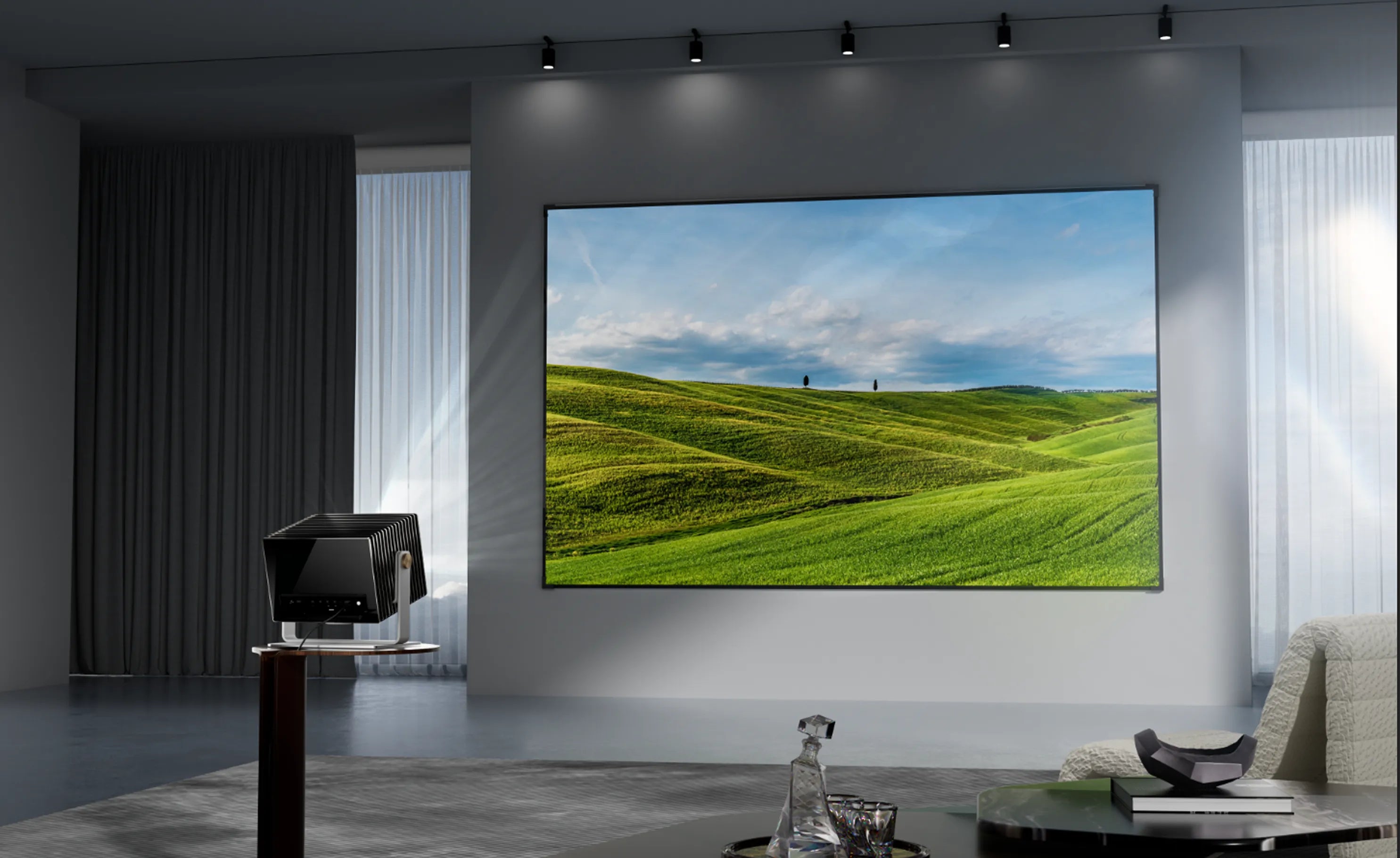When selecting a projector for your home theater, understanding the distinctions between DLP (Digital Light Processing) and LCD (Liquid Crystal Display) technologies is crucial for making an informed decision. Both offer unique advantages, but which one suits your needs?
At Valerion, we’re passionate about delivering cinematic-grade experiences, and our VisionMaster series leverages cutting-edge DLP technology to redefine home entertainment.
Let’s dive into the DLP vs. LCD projector debate to help you choose wisely.
What Is a DLP Projector?
DLP projectors, pioneered by Texas Instruments, use a digital micromirror device (DMD) chip with millions of tiny mirrors to reflect light and create images. A spinning color wheel filters light into red, green, and blue, producing vibrant visuals. DLP projectors, such as the Valerion VisionMaster Pro 2, are renowned for their sharp images, high contrast, and compact design, making them an ideal choice for home theater enthusiasts.
What Is an LCD Projector?
LCD projectors pass light through three liquid crystal panels, one for each primary color: red, green, and blue, to create images. This technology, often called 3LCD in branded models, is popular because of its bright output and color accuracy, especially in well-lit environments. However, LCD projectors are generally bulkier and may need more maintenance than DLP models.
Key Differences Between DLP and LCD Projectors
Here’s a breakdown of the main differences to help you decide:
1. Image Quality and Contrast
- DLP: Excels in delivering deep blacks and high contrast ratios, making it perfect for dark, cinematic environments. The Valerion VisionMaster Pro 2, for example, boasts a 15,000:1 dynamic contrast ratio with its Enhanced Black Level (EBL) mode, ensuring stunning depth in dark scenes.
- LCD: Offers sharp details and vibrant colors but often struggles with lower contrast ratios, resulting in less defined blacks. This can make images appear washed out in darker settings.
2. Brightness
- DLP: While bright, DLP projectors may lose some light due to the color wheel, making them slightly less effective in bright rooms. However, Valerion’s VisionMaster Max delivers up to 3,500 ISO lumens, ensuring vivid visuals even in moderate ambient light.
- LCD: Known for high brightness, LCD projectors are ideal for daytime use or rooms with ambient light, as they pass light directly through panels with minimal loss.
3. Portability and Design
- DLP: Due to their compact and lightweight single-chip design, DLP projectors are easy to move or set up. The Valerion VisionMaster series combines sleek design with portability, perfect for room-to-room use or outdoor movie nights.
- LCD: Bulkier due to three LCD panels, making them less portable and better suited for fixed installations.
4. Maintenance and Durability
- DLP: Requires less maintenance thanks to a sealed chip design that protects against dust. The Valerion VisionMaster’s RGB triple laser light source lasts over 25,000 hours, reducing replacement costs.
- LCD: More susceptible to dust and pixel burnout, requiring regular maintenance like air filter cleaning or panel replacement, which can increase long-term costs.
5. Visual Artifacts
- DLP: Some users may notice the “rainbow effect,” brief flashes of color in fast-moving scenes, though modern DLP projectors like Valerion’s minimize this with advanced technology.
- LCD: Avoids the rainbow effect but may exhibit the “screen door effect,” where pixelation is visible, especially in lower-resolution models.
Why Choose a DLP Projector Like Valerion’s VisionMaster?
For home theater enthusiasts, DLP projectors often outshine LCD models in cinematic settings. The Valerion VisionMaster series combines DLP’s strengths—sharp 4K resolution, high contrast, and vibrant colors—with innovative features like:
- 110% Rec 2020 color gamut for lifelike visuals.
- Dynamic Iris and EBL for exceptional black levels in low-light scenes.
- Google TV OS for seamless streaming.
- Low input lag (4ms at 1080p/240Hz), ideal for gaming.
These features make Valerion’s DLP projectors a top choice for immersive movie nights, gaming, and 3D content, all while offering a compact and durable design.
When to Choose an LCD Projector?
LCD projectors are a great fit if you prioritize brightness for daytime viewing or need a budget-friendly option for presentations or casual use. However, for a premium home theater experience, their lower contrast and bulkier design may fall short compared to DLP models like Valerion’s.
Conclusion: DLP or LCD?
Choosing between a DLP and an LCD projector depends on your needs:
- Choose DLP for home theater setups, gaming, or portable use, where high contrast, sharp images, and durability are most important.
- Choose LCD for bright environments or budget-conscious setups where maintenance isn’t a concern.
For the best home entertainment experience, check out the Valerion VisionMaster series. It features DLP technology, bright colors, and innovative features. It’s an excellent option for turning your space into a personal cinema.
Want to improve your home theater? Discover the Valerion VisionMaster Pro 2 or VisionMaster Max today and experience the future of projection.






